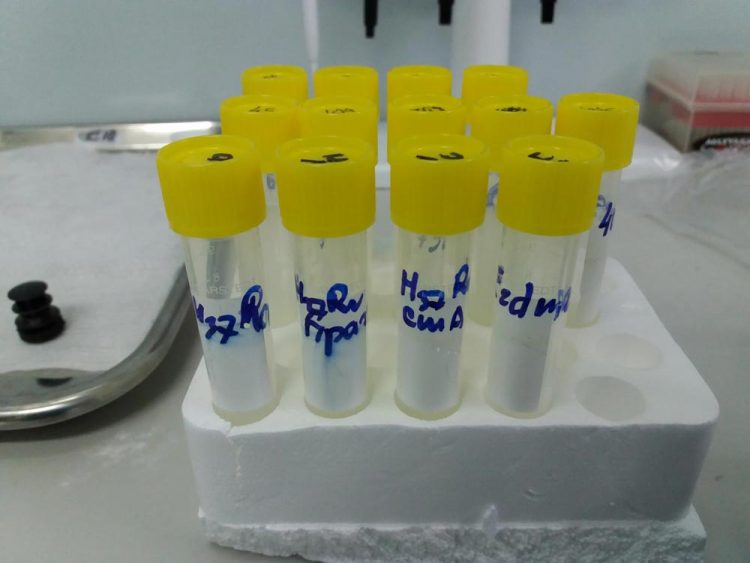BFU physicists developed a new method to identify antibiotics-resistant bacteria

This is a holder with samples of mycobacterial strains with different antibiotic resistance. Courtesy of Andrey Zyubin
A team of physicists from Immanuel Kant Baltic State University suggested a method to quickly identify single antibiotic-resistant bacteria cells that are the agents of tuberculosis. The new method helps find the bacteria and evaluate their resistance to antibiotics without damaging the biological material.
The results of the first trial of the method were published in Data in Brief.
Tuberculosis remains one of the main causes of death in the world. According to the World Health Organization, over 1.5 mln people died of it in 2017. Each year the number of those infected with tuberculosis increases by 10 mln.
The disease caused by antibiotic-resistant strains of Mycobacterium tuberculosis is the most dangerous. The strains of the Beijing family (named after the city they were first observed in) have also become resistant to many medicinal drugs. Methods of quick identification of drug-resistant bacteria are required both for clinical practice and scientific research.
A team of researchers from Immanuel Kant Baltic Federal University together with their colleagues from Saint-Petersburg State Research Institute of Phthisiopulmonology and Saint-Petersburg State University suggested using Raman scattering spectrography to quickly analyze bacterial cells.
This method helps identify the composition and structure of the studied material based on the scattering of laser radiation with certain wavelength by its sample. Spectroscopy is a non-invasive method, i.e. the material under study is not subject to any mechanical impact or destruction.
The study materials were provided by Saint-Petersburg State Research Institute of Phthisiopulmonology. The authors used bacterial strains obtained from lung expectorations of tuberculosis patients, as well as from bone tissue samples taken during surgeries. Before the experiments with Raman scattering spectrography the level of drug resistance of the bacteria was determined using standard biological and chemical methods.
To obtain information about the structure of the cells belonging to different strains, the scientists pointed the laser beam at different bacteria during the spectroscopy procedure. The cells of different strains appeared to scatter the light differently because resistance to antibiotics occurs, among other things, due to changes in the composition of bacterial cell wall components. Spectroscopy helped identify differences in the cell walls of drug-resistance and drug-sensitive bacteria.
The materials published by the authors included the images of strain bacterial cultures with different resistance to antibiotics and Raman spectrums typical for them. The information on bacteria from lungs and bone tissue was provided separately.
“The data published by us contains information of spectrums typical for different strains of Mycobacterium tuberculosis. According to the results of the experiment, Raman spectroscopy may be a useful tool for determining the levels of drug resistance in tuberculosis agents,” says Andrey Zyubin, a senior research associate at the Scientific and Educational Center “Fundamental and Applied Photonics. Nanophotonics”.
Media Contact
All latest news from the category: Life Sciences and Chemistry
Articles and reports from the Life Sciences and chemistry area deal with applied and basic research into modern biology, chemistry and human medicine.
Valuable information can be found on a range of life sciences fields including bacteriology, biochemistry, bionics, bioinformatics, biophysics, biotechnology, genetics, geobotany, human biology, marine biology, microbiology, molecular biology, cellular biology, zoology, bioinorganic chemistry, microchemistry and environmental chemistry.
Newest articles

Sea slugs inspire highly stretchable biomedical sensor
USC Viterbi School of Engineering researcher Hangbo Zhao presents findings on highly stretchable and customizable microneedles for application in fields including neuroscience, tissue engineering, and wearable bioelectronics. The revolution in…

Twisting and binding matter waves with photons in a cavity
Precisely measuring the energy states of individual atoms has been a historical challenge for physicists due to atomic recoil. When an atom interacts with a photon, the atom “recoils” in…

Nanotubes, nanoparticles, and antibodies detect tiny amounts of fentanyl
New sensor is six orders of magnitude more sensitive than the next best thing. A research team at Pitt led by Alexander Star, a chemistry professor in the Kenneth P. Dietrich…





















